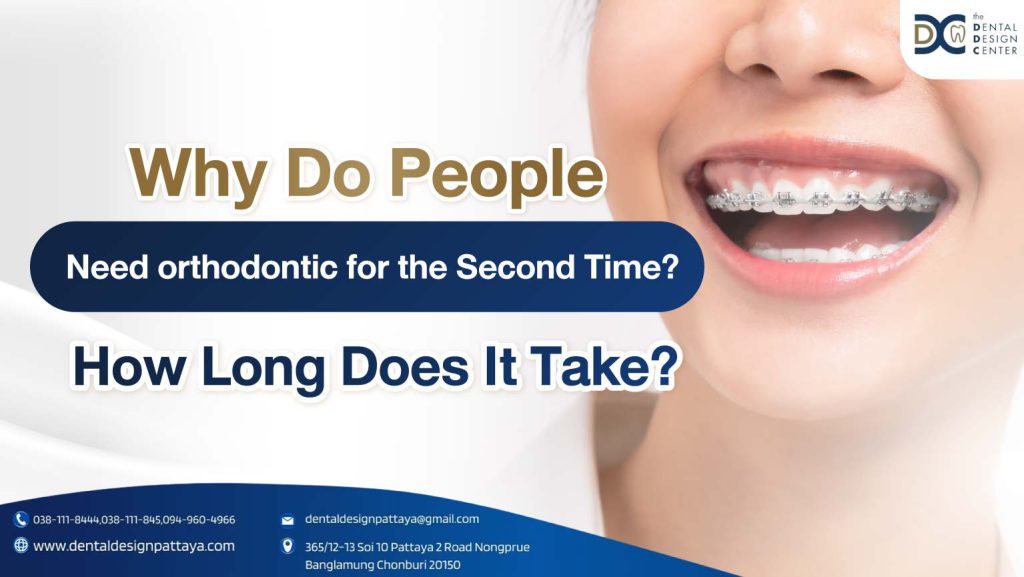Table of Content
- Reasons for Needing Orthodontic Treatment a Second Time
- Teeth Shifting After the First Treatment
- Jawbone Issues
- Newly Developed Issues with Crooked Teeth
- Problems Caused by Malocclusion
- Does a Second Round of Orthodontic Treatment Take Longer?
- What Types of Orthodontic Treatments Are Available for the Second Round?
- Can You Undergo Orthodontic Treatment a Second Time at an Older Age?
- Conclusion
Many individuals who have previously undergone orthodontic treatment may find themselves needing a second intervention. While the primary goal of orthodontics is to correct dental issues, there are several reasons why someone might require additional treatment. In this article, we’ll explore the common causes for needing orthodontic treatment again and whether this second round is time-consuming.
Reasons for Needing Orthodontic Treatment a Second Time
Orthodontic treatment aims to improve and correct dental alignment. However, several factors can lead to the necessity of a second round of treatment. Here are some common reasons:
Teeth Shifting After the First Treatment
One of the most common issues faced by individuals who have undergone orthodontic treatment is the shifting of teeth back to their original positions. This often occurs when patients do not follow their orthodontist’s guidance regarding retainer usage or do not wear retainers for the recommended duration. As a result, teeth may become misaligned again, detracting from the initial improvements and affecting the overall aesthetics of the smile.

Jawbone Issues
The jawbone plays a significant role in the movement of teeth. Abnormalities in the jawbone can impact the effectiveness of the initial orthodontic treatment, leading to outcomes that fall short of expectations. Additionally, changes in the jawbone over time, whether due to growth or other factors, can cause teeth to shift or misalign after treatment has been completed.
Newly Developed Issues with Crooked Teeth
After undergoing orthodontic treatment, it is not guaranteed that issues with crooked teeth will not return. Several factors can contribute to the reappearance of crooked teeth, such as improper chewing habits or other everyday behaviors that affect dental alignment. In these cases, a subsequent round of orthodontic treatment may be necessary to correct these problems.
Problems Caused by Malocclusion
Malocclusion occurs when the upper and lower teeth do not align properly, which can lead to issues with the jaw and facial muscles, as well as difficulties in chewing food. A second round of orthodontic treatment may be the most effective solution for addressing these issues and improving the bite for better function and comfort.
Does a Second Round of Orthodontic Treatment Take Longer?

The duration of the second round of orthodontic treatment is typically not much longer than the first. Each case is evaluated based on the specific dental issues that need to be addressed. However, the time required for a second round may vary depending on the complexity of the problem. It may take slightly longer than the first round, especially as the orthodontist will need to carefully assess why the issue arose initially and whether the patient is eligible for further treatment.
What Types of Orthodontic Treatments Are Available for the Second Round?
Many individuals facing dental issues that require a second round of orthodontic treatment may wonder about the options available. There are no limitations on the types of orthodontic treatments that can be utilized for the second round. Similar to the first round, there are four popular types of orthodontic treatments suitable for a second round:
- Ceramic Braces
- Metal Braces
- Damon Braces
- Invisalign
Patients have the option to choose their preferred type of orthodontic treatment. However, it is essential to discuss and receive an evaluation from a dentist to determine whether a specific option is suitable or if a more effective treatment method is available. The primary goal is to ensure that any second round of orthodontic treatment is the final one.
Can You Undergo Orthodontic Treatment a Second Time at an Older Age?
Orthodontic treatment can generally be performed at any age, depending on the individual’s dental condition. However, it is important to note that age can impact the duration and effectiveness of the treatment. As we age, our teeth may undergo wear or a decrease in strength, which can influence treatment outcomes. Therefore, consulting with an orthodontist before undergoing any orthodontic treatment, whether it is the first or second time, is crucial.
Conclusion
A second round of orthodontic treatment is typically necessary for individuals who have experienced issues with their teeth following their first treatment. These problems can arise from various factors, including jawbone growth, changes, and everyday habits that lead to crooked teeth or misalignment.
For those seeking a second round of orthodontic treatment and looking for an dentist pattaya, you can contact Dental Design Center. We provide a wide range of orthodontic treatments and comprehensive consultations to support your oral and dental health.

